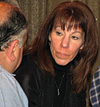
Barbara Dolim, executive director of the Mechanical Service Contractors of America (MSCA), listens to an attendee of the 2008 HVAC Excellence National HVACR Educators and Trainers Conference.
“This is always a good conference for me,” said Silberstein, who finished runner-up in The NEWS’ 2007 Best Instructor contest.
The more than 300 attendees had plenty to see, hear, and learn at the second annual meeting. HVAC Excellence put together a variety of offerings, everything from sessions on green awareness to 410A safety and training. In all, instructors had nearly 30 technical and educational breakout sessions each could have attended, plus the opportunity to visit nearly 40 vendors and industry exhibitors.
Each also had the opportunity to listen to what experts had to say regarding the United Association, economic perspective on the prospects for HVAC technicians, employment opportunities, new federal accountability requirements of schools, Montreal Protocol changes, and the changes in refrigerants.
“Technologies are changing,” said Thomas Tebbe, national program director for HVAC Excellence. “There is an energy efficiency revolution to whose wave of innovation and new technology we must all adapt. Adaptation requires that we continually update our skills and programs.
“With energy costs rising and concern about our carbon footprint, we will need to maximize the performance efficiency of our existing equipment. Therefore, it becomes necessary to include in our programs energy conservation service practices and energy management technology.
“There are many HVACR education challenges that lie ahead of us. Working together, we will meet the challenges of today and tomorrow.”
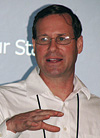
Tav Commins of the California Energy Commission discusses energy efficiency standards for residential and nonresidential buildings in California at the 2008 HVAC Excellence National HVACR Educators and Trainers Conference.
INDUSTRY OPPORTUNITIES
Richard Holden, regional director for the United States Department of Labor (DOL), Bureau of Labor Statistics, and Barbara Dolim, executive director of the Mechanical Service Contractors of America (MSCA), provided plenty for the audience to digest at the opening session and breakfast.Holden provided a thorough discussion of employment opportunities in the HVAC industry, trends in which sectors the most jobs will be most prevalent, employment projections through 2016, and the industry’s move to energy-efficiency systems of greater complexity. The session was designed to provide attendees information on how to gear their respective programs to the jobs that will be in demand in the years to come.
Holden listed energy costs, policy initiatives, building stock, replacement demand, retirees, and regional differences as some of the factors that will affect HVAC employment.
Dolim, on the other hand, painted a bright future for the industry, noting that there will be an 18 to 26 percent growth over the next 10 years. However, with an aging workforce, she spoke of a dire need for qualified replacements. “Apprenticeship cannot meet up with the demand,” she said. “This is why MSCA and the UA started the 5 Star Career program.”
In a nutshell, the program provides free training for future techs, providing the latest and off-line educational tools. In the program, a person can earn 32 credits towards an associate’s degree. The program is a blend of on-the-job and classroom training. Typically this means 1,700 to 2,000 hours of on-the-job training and 216 hours of classroom instruction each year of the five-year program.
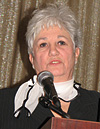
Attendees heard from keynote speaker Dr. Pat Stanley, deputy assistant secretary for the United States Department of Education, Office of Vocational and Adult Education.
CUSTOMER SERVICE 101
Attendees were free to attend several sessions after the morning introduction. Steve Coscia of Coscia Consulting provided one of those sessions, “Customer Relations.” He talked about the importance in teaching students soft skills in conjunction with the technical skills. He noted his “HVAC Customer Service Handbook” could be used as a textbook, as he offers an accompanying instructor’s guide, complete with CD and completion exam booklet. He walked through his lesson plan program for attendees.“How important is it for a tech to know his stuff?” he asked his audience. While all agreed it was important, Coscia added, “You need to know how to convey that you know your stuff.”
Because a service tech needs to think and respond quickly to situations, Coscia stressed his “split second response” method. Simply put, this means pausing and then taking a deep breath in order to think rationally before producing an answer or solution.
“One or two seconds can make all the difference,” said Coscia, adding that listening attentively is next in line before preparing to say what you can do. “Saying what you can do is more constructive than saying what you can’t do.”
In providing service, do it with a smile, too, he encouraged. “It changes the whole demeanor,” he said. This includes being courteous. “Use ‘May I…’ instead of “Can I…,’ ” he said.
In handling problems, Coscia recommended his contain, qualify, and control solution. In essence, it means letting the customer speak his mind before providing any input. “At its core, problems are usually events gone wrong,” he said.
The consultant noted the importance of reading body language, pronouncing and enunciating words properly and correctly, plus providing a soothing tone of voice. “Eighty percent of what we hear is tone of voice,” he said. “Twenty percent is content.”
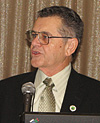
Thomas Tebbe, national programs director for HVAC Excellence, makes a point at the organization’s recent conference, held in Las Vegas.
SPEAKERS ADDRESS ISSUES
At the noon luncheon, attendees heard from keynote speaker Dr. Pat Stanley, deputy assistant secretary for the United States Department of Education, Office of Vocational and Adult Education, who discussed new federal accountability requirements. She zeroed in on the Carl D. Perkins Career and Technical Education Improvement Act of 2006, better known as Perkins IV, which deals with changes in career and technical education, which includes HVACR programs. “Perkins IV is all about accountability and making certain that students have employment-ready skills when they graduate,” she said.Under Perkins IV, students who graduate from HVACR programs will have to successfully pass an industry-recognized credential, the credential being a student assessment meeting Title 34 accountability. In simple terms, a student will need to pass an examination, such as the HVAC Excellence Employment Ready exams, in order to be compliant with their Perkins funding.
“We all need to be working together,” she told the crowd.
The following morning, Cindy Newberg, lead analyst for domestic implementation of the HCFC phaseout at the United States Environmental Protection Agency (EPA), provided a thorough, in-depth rundown regarding the evolution of and changes to the Montreal Protocol. She discussed the more aggressive phaseout of HCFCs, including R-22; the domestic implementation, including new limits on production and import, of HCFCs; and what that means for those that service air conditioning and refrigeration appliances.
“After 2010, supplies will be limited,” she said, referring to R-22. “After 2015, supplies will be cut back again.”
She noted the EPA has plans to propose a ban on the sale and distribution of R-22 in interstate commerce of all air conditioning and refrigeration equipment, similar to the ban on sale and distribution of air conditioning and refrigeration appliances containing CFCs.
Nick Strickland, next in line at the podium, fielded questions regarding refrigerants. As the marketing development manager for DuPont Iseon® refrigerants, Strickland gave a brief rundown regarding his company’s Iseon M029 (R-422D), considered an R-22 replacement. Even though the cost of R-22 will continue to go up rather than down, he still thought over the next few years customers will opt to maintain existing equipment rather than purchasing new equipment - even if the cost of R-22 is now twice the cost today.
Before the conference concluded, Terrence Urbanek, assistant director of training with the United Association (UA), discussed the union’s recruitment needs and showed a video of what the union is currently doing to get more in the field. In addition, he discussed a new international articulation between the UA, its locals, and HVAC Excellence-accredited programs.
In simple terms, students graduating from an HVAC Excellence-accredited program who have a C average or higher and pass six of the HVAC Excellence student assessments, will be granted advanced placement within the UA apprenticeship program.
“This is a great program,” said Howard Weiss, director of marketing for HVAC Excellence, who also doubled as master of ceremonies.
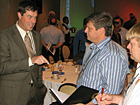
After speaking to attendees, Nick Strickland (left) takes time to answer some more questions from attendees. Strickland is marketing development manager for DuPont Iseon® refrigerants.
A NOD FOR ACCREDITATIONS
Accreditations were also given their moment in the limelight. According to Weiss, HVAC Excellence has accredited 17 programs over the last year. Weiss noted that in the last few weeks, three additional programs were granted accreditation: Walla Walla Community College (Washington); Washington State Penitentiary (Washington), and Mid West Technical Institute (Illinois), were all presented their accreditation plaques during the awards ceremony.“Accreditation has taken the industry a long way in a short time,” said Weiss. “It was March of 1999 when the Tennessee Board of Regents ordered all technical programs to be accredited. Having contacted all of the HVACR industry associations, they found out there was no such accreditation for the HVACR industry, nor was anyone interested in creating one. That is, until they contact HVAC Excellence.” Working together to research standards and develop a program, Weiss said HVAC Excellence rolled out HVACR programmatic accreditation later that year.
Bruce Nelson of the Tennessee Technology Center (Tennessee) and Randy Lowe of Hawkeye Community College (Iowa) each earned Certified Master HVAC Educator (CMHE). The title of CMHE is not easily attained, as it demonstrates that a person is at the top of their field in six specialty areas, explained Weiss. To earn the status of CMHE, an instructor must obtain a passing score of 80 percent or better on six area-specific HVAC Excellence Certified Subject Matter Educator (CSME) exams. In addition, the instructor has to pass the HVAC Excellence Capstone exam that covers technical education methodologies.
“Earning the status of CMHE is no easy feat,” said Weiss.
Other highlights from the event:
• David Boyd, vice president of sales and training for Appion, announced a program where all HVACR programs in the United States can qualify for free recovery machines.
• Delmar Cengage Learning introduced the 6th edition ofRefrigeration and Air Conditioning Technologyand introduced their new contributor, professor Silberstein.
• Hampden Engineering introduced new green trainers for the HVACR industry and discussed their new green trailers.
Visit www.hvacexcellence.org for more information on the 2008 National HVACR Educators and Trainers Conference. More information on this new alliance between education and industry can be found at www.5starcareers.com.
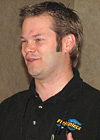
Russell Harju of Fieldpiece Instruments preaches the importance of proper testing, which he considered the first step in the verification process to validate system performance and energy efficiency.
Sidebar: Awards, Too
Like most conferences, the 2008 HVAC Excellence National HVACR Educators and Trainers Conference set aside some time to honor a few:•Career Connection Award:Barbara Dolim, executive director of the Mechanical Service Contractors of America (MSCA), received the award for creating the Five Star Program, a “true connection between education and industry.”
•Leadership Award: Mark Stokes, corporate trainer for Goodman Manufacturing, for “his leadership in helping others achieve excellence in training.”
•Prometheus Award: Robert Fletcher of Intellitec College for his innovative teaching ideas. He created a “Room of Doom” at his school to point out the carbon dioxide issue. It was so successful, he is now building the “Apartment of Death” to point out some indoor air quality issues.
•Green Award:Tom Crandell, director of Corporate and Professional Development Center (CPD) at Ferris State University, for his involvement in creating the green awareness movement in the HVACR industry.
•Award of Merit:Mark Nichols of the Louisiana Community and Technical College System, for “going above and beyond the call of duty in helping his peers to achieve their fullest potential.”
Publication Date:04/14/2008

Report Abusive Comment